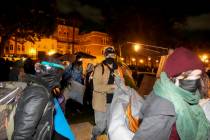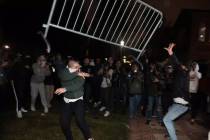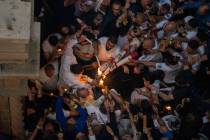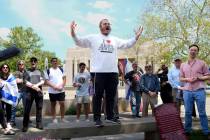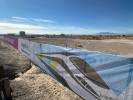Power corridor plan draws protest
WASHINGTON -- The Department of Energy is moving forward to designate a broad corridor through Southern Nevada, Arizona and Southern California where it would be easier to build 125-foot-tall high voltage transmission lines to ferry electricity around the region.
The plan, which is nearing the end of a public comment period, has drawn protests from officials in Nevada and Arizona, wilderness defenders and property advocates. Opponents failed to block it in Congress.
The designation of a National Interest Electric Transmission Corridor was set in motion by Congress two years ago to streamline construction of high voltage power lines to relieve congested power grids.
It stemmed from the August 2003 blackout that left 50 million people without electricity in a swath of Great Lakes states and parts of New England.
Clark County is in the proposed southwestern corridor because the federal power substation at Lake Mead that relays electricity from Hoover Dam and from power producers in the Midwest is seen as a key element, said Kevin Kolevar, director of the Office of Electricity Delivery and Energy Reliability.
The corridor also encompasses La Paz, Maricopa and Yuma counties in Arizona. In California, Imperial, Kern, Los Angeles, Orange, Riverside, San Bernardino and San Diego counties are included.
The Energy Department also is designating a Mid-Atlantic corridor from Virginia to New York that also includes parts of Ohio and West Virginia.
DOE officials said speedy development of power lines is necessary to avoid blackouts as electricity demand rises while the nation's power grids' capacity falls to keep pace.
"The fact is electricity needs are growing," Kolevar said. Electricity sales are expected to increase 41 percent by 2030 nationwide, according to the Energy Information Administration.
The corridors are not final yet. The DOE will submit a draft to the Federal Energy Regulatory Commission for approval sometime after a public comment period ends on July 6.
But critics say the plan infringes on states' rights, granting authority to federal agencies to locate transmission routes over the protests of local communities.
Environmentalists complain it could lead to power lines being strung through national forests and other protected areas. Federal officials say there are no plans to do that.
The Energy Policy Act of 2005 gave Energy Secretary Samuel Bodman the authority to identify electricity congestion areas. A corridor designation would allow developers to appeal to the Federal Energy Regulatory Commission in order to overcome siting objections, and would allow eminent domain to be invoked to acquire property for transmission towers.
The commission would be charged with determining if the project is necessary to relieve demands for electricity. It would be required to perform an environmental impact study before authorizing transmission projects.
"It's going to be disastrous," said Alan Ackerman, a Michigan-based lawyer who specializes in eminent domain law who writes a blog about the project. "People don't have a sense of how unfair the system can be."
The Nevada Public Utilities Commission opposes the plan. Arizona public utility officials have the same position.
The Nevada commission is concerned about the "potential of losing state rights by FERC having the ability to permit transmission lines after the commission has justifiably denied the permit," spokeswoman Kristy Wahl said.
State and federal lands within the corridor, including national parks and Bureau of Land Management wildlife preserves, would be off-limits unless the agencies that oversee them agree to the siting of transmission facilities.
But The Wilderness Society is calling for more specific protections. In Southern Nevada, the group has identified Red Rock Canyon, the Desert National Wildlife Refuge and the Lake Mead National Recreation Area as in the corridor path.
"The (Energy Department) is not being careful," said Nada Culver, Wilderness Society senior counsel. Mary Morton, an Energy Department attorney, said the DOE would consider strengthening wilderness protections in the final plan.









